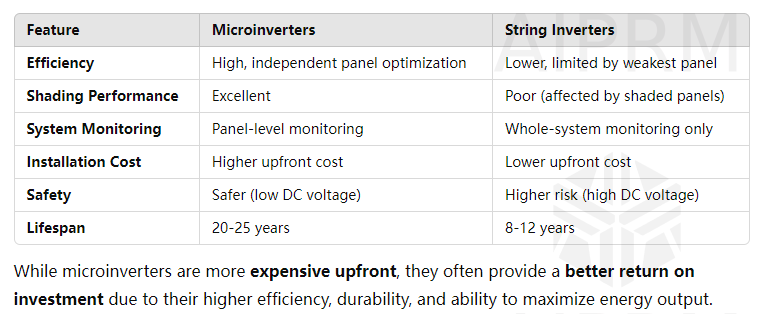As solar energy technology advances, the way we convert sunlight into usable electricity is also evolving. Traditional string inverters have long been the standard in solar panel installations, but microinverters are now gaining popularity due to their efficiency, reliability, and ability to maximize energy output.
Microinverter solar systems offer several advantages over conventional inverters, including improved performance in shaded conditions, enhanced safety, and better monitoring capabilities. In this article, we will explore what microinverters are, how they work, their advantages, and whether they are the right choice for your solar energy system.
What is a Microinverter Solar System?
A microinverter is a small, independent inverter that is installed directly on each solar panel. Unlike traditional string inverters, which connect multiple panels in series and convert their collective DC (direct current) output into AC (alternating current), a microinverter converts the DC power from a single panel into AC electricity right at the source.
This means that every solar panel operates independently, preventing the performance issues commonly associated with partial shading, dirt accumulation, or panel degradation.
How Do Microinverters Work?
Sunlight Hits the Solar Panel – The photovoltaic (PV) cells in the panel generate DC electricity.
DC to AC Conversion – Instead of sending this DC power to a central inverter, a microinverter installed on the back of the panel immediately converts it into AC electricity.
Energy Distribution – The AC power is then sent directly to your home’s electrical system or the grid, where it can be used for appliances, lighting, and other energy needs.
Individual Panel Monitoring – Each microinverter comes with built-in monitoring capabilities, allowing you to track the performance of every panel in real-time.
This individual conversion and monitoring system is what makes microinverter solar systems more efficient and reliable than traditional inverter-based setups.
Advantages of Microinverter Solar Systems
1. Maximum Energy Output
One of the biggest benefits of microinverters is that they optimize the energy production of each individual panel. If one panel is shaded or dirty, it does not affect the performance of the other panels, unlike string inverters where all panels are affected by the weakest one.
2. Improved Efficiency in Shaded Areas
Since microinverters allow each panel to operate independently, they are ideal for installations in areas where shade from trees, buildings, or clouds may be an issue. Even if one or more panels are partially shaded, the rest of the system continues to generate energy at maximum efficiency.
3. Enhanced System Monitoring
Microinverters provide panel-level monitoring, which means you can track the performance of each individual panel through a mobile app or web platform. This feature helps homeowners and technicians detect and fix issues faster.
4. Increased Safety
Traditional inverters require high-voltage DC power to travel across the system before conversion, which can pose safety risks. Microinverters convert DC to AC immediately at the panel, reducing the risk of electrical fires and improving overall system safety.
5. Longer Lifespan and Warranty
Most microinverters come with warranties of 20-25 years, compared to string inverters that typically have warranties of 8-12 years. This longer lifespan makes microinverters a better long-term investment for solar energy users.
Microinverters vs. String Inverters: Which One is Better?

Are Microinverters Worth It?
Microinverters are an excellent choice for:
✅ Homes with Partial Shading – If your roof experiences shade at different times of the day, microinverters will prevent significant energy loss.
✅ Roof Installations with Multiple Orientations – If your panels face different directions (e.g., east and west), microinverters allow each panel to perform at its best.
✅ People Who Want the Latest Solar Technology – If you prefer the most advanced solar solution with smart monitoring, microinverters are the way to go.
However, if you have a large-scale solar system in an open, unshaded area, a string inverter might be a more cost-effective option.
Conclusion
Microinverter solar technology is a smart, efficient, and reliable way to maximize the benefits of solar energy. With their higher efficiency, panel-level monitoring, and improved safety, microinverters are an excellent investment for homeowners looking to get the most out of their solar power system.
If you are considering upgrading your solar installation, microinverters offer a future-proof solution with long-term benefits. For more information on solar energy solutions and professional installation services, visit Microinverter Factory.
